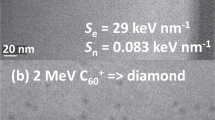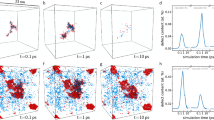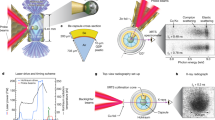Abstract
THE mechanisms by which fast, heavy, and charged particles lose energy to crystalline matter are generally explained in terms of either thermal1 or displacement2 spikes. The mere fact, however, that a majority of the energy is dissipated in the excitation of orbital electrons and the creation of a thermal spike does not necessarily imply that the resulting radiation damage is so formed. In uranium, for example, the existence of a continuous band of energy-levels above the Fermi surface permits a temporary excitation of the valence electrons, since these may fall back to their original levels and so deliver their energy to the lattice as heat. For such cases, the bulk of the remanent radiation damage may well derive from the Coulomb interactions which the particle makes with lattice atoms in the crystal. Brinkman3 has shown, by use of the atomic interaction potential:  which approximates to a Coulomb repulsion for close interactions and a Born-Mayer exponential repulsion for large separations, that, for a light uranium fission fragment travelling through uranium, atomic displacements are produced every 40 Å on the average. Occasionally the displacement produces a highly energetic (∼ 105 eV) primary knock-on which proceeds to lose energy by hard-sphere collisions. In such cases a displacement spike can be formed. Atoms are driven into the surrounding lattice to occupy interstitial positions on a closed shell which surrounds a core of vacant lattice sites.
which approximates to a Coulomb repulsion for close interactions and a Born-Mayer exponential repulsion for large separations, that, for a light uranium fission fragment travelling through uranium, atomic displacements are produced every 40 Å on the average. Occasionally the displacement produces a highly energetic (∼ 105 eV) primary knock-on which proceeds to lose energy by hard-sphere collisions. In such cases a displacement spike can be formed. Atoms are driven into the surrounding lattice to occupy interstitial positions on a closed shell which surrounds a core of vacant lattice sites.
This is a preview of subscription content, access via your institution
Access options
Subscribe to this journal
Receive 51 print issues and online access
$199.00 per year
only $3.90 per issue
Buy this article
- Purchase on Springer Link
- Instant access to full article PDF
Prices may be subject to local taxes which are calculated during checkout
Similar content being viewed by others
References
Seitz, F., Disc. Farad. Soc., 5, 271 (1948).
Brinkman, J. A., App. Phys., 25, 961 (1954).
Brinkman, J. A., U.S. Rep. NAA-SR-6642 (1962).
Bowden, F. P., and Chadderton, L. T., Proc. Roy. Soc., A (in the press).
Silcox, J., and Hirsch, P. B., Phil. Mag., 4, 1356 (1958).
Bowden, F. P., and Chadderton, L. T., Nature, 192, 31 (1961).
Author information
Authors and Affiliations
Rights and permissions
About this article
Cite this article
CHADDERTON, L. Experimental Evidence for the Concept of the Displacement Spike. Nature 195, 987–988 (1962). https://doi.org/10.1038/195987a0
Issue Date:
DOI: https://doi.org/10.1038/195987a0
Comments
By submitting a comment you agree to abide by our Terms and Community Guidelines. If you find something abusive or that does not comply with our terms or guidelines please flag it as inappropriate.



